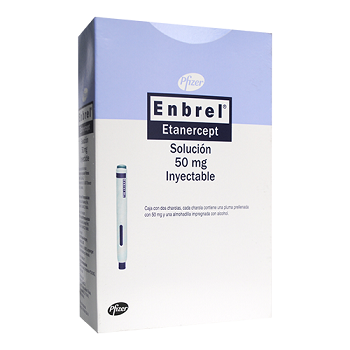| Description | Etanercept is produced by recombinant DNA technology in a Chinese hamster ovary mammalian cell line
and is the first biotechnology-derived drug to be introduced for the reduction of the signs and symptoms of
moderately to severely active rheumatoid arthritis in patients who have not adequately responded to one or more of
the synthetic DMARDs. It is a dimeric soluble form of the p75 TNFR capable of binding to two TNF molecules in the
circulation. It consists of the extracellular ligand binding portion of the 75-kDa human TNFR fused to the Fc portion
of human IgG1.

The Fc component of etanercept contains the CH2 domain, the CH3 domain, and the
hinge region, but not the CH1 domain of IgG1. It consists of 934 amino acids and has an apparent molecular weight
of approximately 150 kDa. Two TNFRs have been identified, a 75-kDa protein and a 55-kDa protein, that occur as
monomeric molecules on cell surfaces and soluble forms in the blood. The biological activity of TNF requires its
binding to either of the two cell surface TNFRs. Etanercept can bind specifically to two molecules of TNFα in the
circulation, preventing its interaction with cell surface TNFRs. |
| Uses | To decrease signs and symptoms of rheumatoid arthritis.

Etanercept (Enbrel) is a soluble TNF receptor fusion protein. It is FDA approved for moderate to severe psoriasis at a dose of 50 mg twice weekly by subcutaneous injection for the initial 12 weeks, followed by a stepdown to 50 mg weekly for maintenance. The most common side effect is injection site reactions. Rare cases of serious infection, demyelinating disease, and congestive heart failure have been reported by postmarketing surveillance.
|
| Indications | Etanercept (Enbrel) is a recombinant fusion protein designed
to block the action of TNF-α.
The drug is composed of the extracellular ligand-binding
portion of the 75-kilodalton human TNF receptor
linked to the Fc portion of human IgG1. TNF-α is a cytokine
thought to play a major role in the pathogenesis
of a number of inflammatory skin diseases, including
psoriasis. Etanercept binds soluble TNF-α, preventing it
from binding to and activating receptors for TNF that
are present on cell membranes. |
| Indications | Etanercept is a recombinant fusion protein produced in
Chinese hamster ovary cells. It consists of the intracellular
ligand-binding portion of the human p75 TNF receptor
linked to the Fc portion of human immunoglobulin
(Ig) G1.Two p75 molecules are attached to each Fc
molecule. Etanercept binds to soluble TNF-αand TNF-β
and forms inactive complexes, effectively lowering
circulating levels of these cytokines. It is administered
subcutaneously, generally twice weekly. |
| Brand name | Enbrel (Immunex);Tanercept yhu. |
| Pharmacology | Etanercept (Enbrel) is a soluble TNF receptor fusion protein. It is FDA
approved for moderate to severe psoriasis at a dose of 50 mg twice weekly
by subcutaneous injection for the initial 12 weeks, followed by a stepdown
to 50 mg weekly for maintenance. |
| Clinical Use | Etanercept is approved in the United States for the
treatment of psoriatic arthritis and rheumatoid arthritis.
Although etanercept has not been specifically approved
for the treatment of the cutaneous manifestations of
psoriasis, it significantly improves the skin lesions of patients
with moderate to severe cutaneous psoriasis who
have used it for psoriatic joint disease. |
| Side effects | The most common adverse reaction to etanercept is
mild to moderate erythema, pain, or pruritus at the injection
site (37%). Headaches and abdominal pain can
also occur. New positive autoantibodies, such as antinuclear
antibodies (ANA), anti-dsDNA antibodies, and
anticardiolipin antibodies, can develop in patients
treated with etanercept. Although there is so far no association
between this and the development of autoimmune
diseases or malignancies, long-term studies have
yet to be done. Rare cases of pancytopenia may be associated
with this drug. Although clinical trials showed
no increased risk of infection with etanercept treatment,
postmarketing reports of serious infections, sepsis,
and associated fatalities exist. |
| Drug interactions | Potentially hazardous interactions with other drugs
Anakinra and abatacept: avoid concomitant use.
Live vaccines: avoid concomitant use. |
| Metabolism | Since etanercept is a fusion glycoprotein, consisting
entirely of human protein components, it is expected to
undergo proteolysis |
| Precautions | Etanercept therapy should not be initiated in patientswith active infection. If an infection develops in a persontaking etanercept, he or she should be closely monitored.If a serious infection or sepsis occurs, the drugshould be discontinued. Etanercept should be usedwith caution in individuals who have conditions predisposingthem to serious infection (e.g., uncontrolleddiabetes, hematological abnormalities). Data on druginteractions are limited. Live virus vaccines are contraindicatedbecause of the potential for secondarytransmission of the infection by the vaccine. Myelosuppressiveantirheumatic agents have been associatedwith pancytopenia in some patients treated with etanercept. |